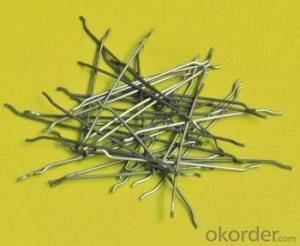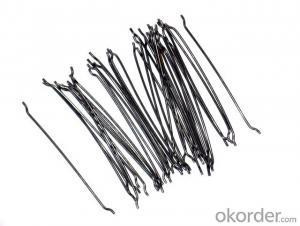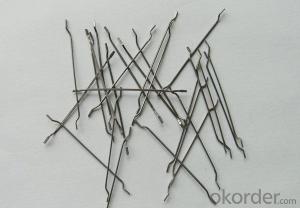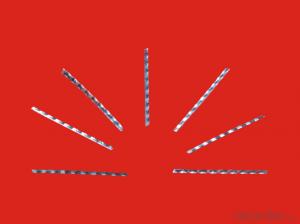Melt Extract Stainless Steel Fiber - Loose Steel Fiber by CNBM China International
- Loading Port:
- Tianjin
- Payment Terms:
- TT OR LC
- Min Order Qty:
- 1000 kg
- Supply Capability:
- 30000 kg/month
OKorder Service Pledge
OKorder Financial Service
You Might Also Like
Quick Details
| Place of Origin: | Hebei, China (Mainland) | Brand Name: | cnbm | Model Number: | CW04 |
| Material: | Steel | Material:: | Steel,low carbon steel wire | Standard:: | ASTM ,ISO9001,CE |
| Shape:: | hooked ends and straight middle | Grade:: | Q195 | Application:: | shortcrete on tunnel, underground project, dam plate |
| Tensile strength:: | 2850Mpa | Demension:: | per your requirement | Place of Origin:: | HeBei China (Mainland) |
| Brand Name:: | ZhiTai steel fiber | Delivery Detail:: | in 7 days upon receive prepayment |
Specifications
Steel fiber for Concrete Reinforcement
1.High tensile strength 2.Length 6-10mm 3.Diameter 0.15-0.3mm
1. diameter: 0.15-0.3mm
2. lengthe: 6-10mm
3. high tensile strength : 2850Mpa
4. It is widely used for concrete reinforcement.
| Packaging Details: | damp-proof poly-bag, 20--25Kg/bag,1000Kg(40bags),1100Kg(44bags)or1200Kg(48bags)/pallet,22,000Kg to 24,000Kg/20' container. |
| Delivery Detail: | 7days |
Picture

Steel fiber


FAQ
certificated: ISO 9001
Technical advantages of Daye steel fiber:
A. Improve mechanical performance of concrete
B. Provide uniform distribution throughout concrete with excellent mixing
C. No balling or caking by adopt correct mixing method
D. Reduce concrete volume
E.Save construction time and cost
F.Reduce excavation volume
G.Available for jointless floor.
- Q: Is melt extract stainless steel fiber compatible with all types of admixtures?
- Melt extract stainless steel fiber is generally compatible with most types of admixtures used in concrete. However, it is important to note that compatibility can vary depending on the specific type and dosage of admixture used, as well as the intended application and performance requirements of the concrete. Stainless steel fibers are typically inert and do not react chemically with most admixtures, which makes them generally compatible. They can be used in conjunction with various types of admixtures such as water reducers, air entraining agents, accelerators, retarders, and superplasticizers. However, it is crucial to consult the manufacturer's recommendations and conduct compatibility tests to ensure that the specific admixture being used is compatible with stainless steel fibers. Some admixtures may have specific guidelines or limitations when it comes to their use with fibers. Admixture manufacturers can provide guidance regarding their compatibility with stainless steel fibers and any potential performance implications. Additionally, it is important to consider the intended purpose of the concrete and the desired properties. Stainless steel fibers can enhance the mechanical properties of concrete, such as its flexural strength, toughness, and durability. However, certain admixtures, such as those designed for specific purposes like corrosion inhibition or shrinkage reduction, may have different requirements or limitations when used in combination with stainless steel fibers. In summary, while melt extract stainless steel fiber is generally compatible with most types of admixtures, it is crucial to consult the manufacturer's recommendations and conduct compatibility tests to ensure optimal performance and avoid any potential issues.
- Q: How does melt extract stainless steel fiber affect the rebound of shotcrete?
- Melt extract stainless steel fiber has a significant impact on the rebound of shotcrete. Shotcrete is a method of applying concrete or mortar through a high-pressure hose onto a surface. During this process, some of the material bounces off the surface, resulting in rebound. Rebound is undesirable as it leads to material wastage and can affect the overall quality and efficiency of the shotcrete application. When melt extract stainless steel fibers are added to the shotcrete mixture, they improve the cohesion and bonding between the concrete or mortar particles. These fibers act as reinforcement, enhancing the structural integrity of the shotcrete and reducing the likelihood of rebound. The fibers create a three-dimensional network within the shotcrete, allowing it to better adhere to the surface and resist the forces that cause rebound. The addition of melt extract stainless steel fibers also improves the ductility and toughness of the shotcrete, making it more resistant to cracking and spalling. This increased durability further minimizes the rebound by ensuring that the shotcrete remains intact upon impact. Moreover, melt extract stainless steel fibers have a high aspect ratio, meaning they are long and thin. This unique shape further enhances their ability to reduce rebound by effectively distributing the forces of impact throughout the shotcrete. The fibers help absorb and dissipate the energy generated during the application process, preventing excessive rebound. Overall, the use of melt extract stainless steel fibers in shotcrete significantly reduces rebound, resulting in more efficient and cost-effective application. The improved bonding, durability, and energy absorption properties of these fibers ensure that a greater proportion of the shotcrete material adheres to the surface, minimizing wastage and enhancing the overall quality of the shotcrete application.
- Q: Does melt extract stainless steel fiber improve the resistance to freeze-thaw cycles of concrete?
- Concrete's resistance to freeze-thaw cycles is indeed improved by melt extract stainless steel fiber. By incorporating stainless steel fibers into the concrete, its durability and performance are enhanced as the detrimental effects of freeze-thaw cycles are minimized. When water freezes within the concrete, it expands and applies pressure on the surrounding matrix, leading to cracks and eventual deterioration of the structure. Nonetheless, the inclusion of melt extract stainless steel fibers helps address these issues. These fibers serve as reinforcement within the concrete, imparting additional strength and preventing crack propagation. This reinforcement effectively boosts the concrete's resistance to the damaging effects of freeze-thaw cycles. Moreover, melt extract stainless steel fibers possess exceptional corrosion resistance properties, further contributing to the concrete's improved durability. Unlike other fiber types, stainless steel fibers do not corrode or degrade over time, ensuring their long-term effectiveness in enhancing freeze-thaw resistance. In summary, the addition of melt extract stainless steel fiber significantly enhances concrete's resistance to freeze-thaw cycles, preventing cracks and extending the structure's lifespan.
- Q: Can melt extract stainless steel fiber be used in basement walls?
- Certainly! Melt extract stainless steel fiber is a suitable option for basement walls. In construction, stainless steel fibers are widely utilized due to their impressive tensile strength and resistance to corrosion. By incorporating these fibers into concrete or other building materials, the overall strength and durability of the structure can be enhanced. Given the potential presence of moisture and the risk of water damage in basement walls, the use of stainless steel fibers can offer added reinforcement, ensuring long-term stability. Moreover, these fibers can effectively minimize the risk of cracking and shrinkage in the concrete, making them an ideal choice for basement walls.
- Q: What is the recommended fiber geometry for melt extract stainless steel fiber in concrete?
- The recommended fiber geometry for melt extract stainless steel fiber in concrete is typically in the form of straight, monofilament fibers. These fibers are usually slender and have a diameter ranging from 0.15 mm to 0.50 mm. The length of the fibers can vary, but it is often recommended to use fibers with lengths between 20 mm to 50 mm for optimal performance in concrete. The use of straight, monofilament fibers offers several advantages in concrete applications. Firstly, these fibers provide excellent bonding with the surrounding concrete matrix, enhancing the overall mechanical properties of the material. Secondly, the straight geometry allows for effective dispersion and distribution of the fibers throughout the concrete, ensuring uniform reinforcement and improved crack control. Additionally, the slender diameter of the fibers allows for easier mixing and placement of the concrete, without significantly affecting the workability of the mixture. It is important to note that the specific fiber geometry may vary depending on the desired performance requirements and the specific application of the concrete. Therefore, it is recommended to consult with manufacturers or experts in the field to determine the most suitable fiber geometry for a particular project.
- Q: What are the requirements for storage and handling of melt extract stainless steel fiber?
- To maintain the integrity and quality of melt extract stainless steel fiber, several key factors must be considered: 1. Temperature: Ensure the storage area maintains a moderate temperature to prevent any adverse effects on the fiber. Extreme temperatures can alter its properties and impact performance. 2. Humidity: Store the fiber in a dry environment to prevent moisture absorption. Moisture can lead to corrosion and weaken the fiber, reducing its effectiveness. 3. Packaging: Keep the fiber in its original packaging or airtight containers to avoid exposure to air, dust, and contaminants. This preserves cleanliness and quality. 4. Handling: When handling the fiber, use appropriate protective equipment like gloves and safety glasses to prevent injuries. Its sharp edges require caution to avoid cuts or abrasions. 5. Avoid contact with other metals: Store the stainless steel fiber separately from other metals, especially those prone to corrosion. Contact with other metals can cause galvanic corrosion, degrading performance. 6. Proper labeling and identification: Ensure the melt extract stainless steel fiber is correctly labeled and identified for traceability and to avoid confusion with other materials. This assists in maintaining quality control and efficient inventory management. Following these storage and handling requirements preserves the melt extract stainless steel fiber's optimal condition, ensuring reliability and longevity in applications such as concrete reinforcement, thermal insulation, and electrical conductivity.
- Q: What is the effect of melt extract stainless steel fiber on the modulus of elasticity of concrete?
- The addition of melt extract stainless steel fibers to concrete can have a positive effect on the modulus of elasticity. Modulus of elasticity refers to the material's ability to deform elastically under stress and then return to its original shape when the stress is removed. The stainless steel fibers act as reinforcement within the concrete matrix, improving its mechanical properties. These fibers enhance the tensile strength of the concrete, preventing crack propagation and increasing its resistance to bending or flexural stresses. As a result, the modulus of elasticity of the concrete is improved. The presence of melt extract stainless steel fibers helps to distribute stress more evenly throughout the concrete, reducing the concentration of stress at specific points and enhancing the overall structural integrity. This allows the concrete to withstand higher loads and provides increased durability. Furthermore, the stainless steel fibers also enhance the bond between the concrete matrix and the fiber itself. This improved bond helps to transmit stress from the matrix to the fibers, further enhancing the overall strength and stiffness of the concrete. In conclusion, the addition of melt extract stainless steel fibers to concrete positively impacts the modulus of elasticity by improving the material's tensile strength, resistance to cracking, and overall durability.
- Q: Is melt extract stainless steel fiber suitable for use in high-performance mortar?
- Yes, melt extract stainless steel fiber is suitable for use in high-performance mortar. It enhances the mechanical properties and durability of the mortar, providing increased flexural and impact strength, as well as improved resistance to cracking, shrinkage, and corrosion.
- Q: What is the effect of melt extract stainless steel fiber on the crack propagation in concrete?
- The primary effect of melt extract stainless steel fiber on crack propagation in concrete is to enhance crack resistance and improve the overall durability of concrete structures. When stainless steel fibers are incorporated into concrete, they create a three-dimensional reinforcement network that promotes a more even distribution of stress throughout the concrete matrix. By dispersing the load and reducing stress concentration at vulnerable points like cracks or weak zones, the stainless steel fibers effectively hinder crack propagation. Acting as micro-reinforcements within the concrete, these fibers bridge cracks and prevent them from spreading further. Stainless steel fibers possess unique properties such as high tensile strength, corrosion resistance, and ductility, which make them particularly effective in boosting concrete's crack resistance. Unlike other fiber types, stainless steel fibers can withstand high tensile stresses and maintain their integrity even in extreme conditions like freeze-thaw cycles or exposure to chemicals. Moreover, the manufacturing process of melt extract stainless steel fibers ensures a high aspect ratio, providing a large surface area for interaction with the surrounding concrete matrix. This increased bond between the fibers and the concrete matrix further enhances crack resistance. Overall, the inclusion of melt extract stainless steel fibers in concrete significantly improves its ability to resist cracking and enhances its durability. Consequently, this leads to extended service life, reduced maintenance expenses, and enhanced safety for concrete structures in various applications such as buildings, bridges, pavements, and tunnels.
- Q: How is the dosage of melt extract stainless steel fiber determined for concrete reinforcement?
- The dosage of melt extract stainless steel fiber for concrete reinforcement is determined based on various factors including the specific project requirements, the type of concrete being used, and the desired properties of the reinforced concrete. The dosage of stainless steel fiber is typically determined by conducting extensive testing and analysis to ensure that the reinforced concrete meets the desired performance criteria. The dosage is usually expressed in terms of weight or volume percentage of stainless steel fiber relative to the total weight or volume of the concrete. The first step in determining the dosage is to evaluate the specific project requirements such as the design strength, durability, and crack resistance of the concrete. This information helps in identifying the necessary properties that the stainless steel fiber should provide to the concrete. Next, laboratory testing is conducted to assess the compatibility between the stainless steel fiber and the concrete mix. This includes evaluating the fiber's bonding characteristics, dispersibility, and its effect on the fresh and hardened properties of the concrete. The dosage is adjusted based on the results of these tests to optimize the performance of the reinforced concrete. Furthermore, the type of concrete being used also plays a role in determining the dosage. Different concrete mixes have different characteristics, such as different aggregate sizes, water-cement ratios, and admixtures. These factors can influence the dosage of stainless steel fiber required to achieve the desired properties. In addition, the desired properties of the reinforced concrete, such as flexural strength, impact resistance, and crack control, also influence the dosage. Higher dosages of stainless steel fiber are generally required for applications that demand superior performance in terms of these properties. It is important to note that the dosage of stainless steel fiber should be carefully determined to avoid any negative effects on the workability of the concrete mix. Excessive dosages can lead to difficulties in placing and finishing the concrete, as well as potential segregation or balling of the fiber. In summary, the dosage of melt extract stainless steel fiber for concrete reinforcement is determined through a comprehensive analysis of project requirements, concrete mix characteristics, and desired properties of the reinforced concrete. Extensive testing and evaluation are conducted to optimize the dosage and ensure that the stainless steel fiber effectively enhances the performance of the concrete.
Send your message to us
Melt Extract Stainless Steel Fiber - Loose Steel Fiber by CNBM China International
- Loading Port:
- Tianjin
- Payment Terms:
- TT OR LC
- Min Order Qty:
- 1000 kg
- Supply Capability:
- 30000 kg/month
OKorder Service Pledge
OKorder Financial Service
Similar products
Hot products
Hot Searches
Related keywords



























